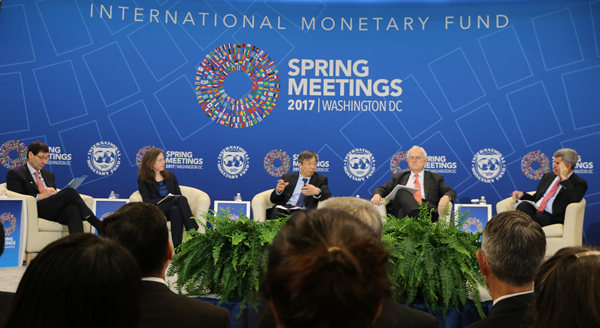Full coverage: China Breakthroughs
By Tom McGregor, CCTV.com Panview commentator and editor
China is taking steps to expand its financial markets and to internationalize the remninbi (RMB, Chinese currency). Beijing has enjoyed remarkable success in its efforts. The IMF (International Monetary Fund) agreed in Nov. 2015 to include the Chinese currency into its basket of SDRs, special drawing rights. The RMB joined the US dollar, UK pound, EU dollar and Japanese Yen as a major reserve currency in Oct. 2016.
As China's yuan rises in prominence, the Chinese government has taken steps to raise its value in the eyes of the world by creating new technologies and systems that support a higher-traded RMB. Hence, plans are underway to develop a new international payments system.
The first phase of the China international payments system (CIPS) was launched in Shanghai on October 8, 2015. And hence forward, businesses operating in Asia and Europe can wire RMB funds, such as remittances, to bank accounts in China, via CIPS.
Formerly, such transactions were conducted by off-shore bank accounts, primarily in London and Hong Kong, routed through SWIFT (society for worldwide interbank financial telecommunication), a network that enables global financial institutions to send and receive information about transactions.
The current global electronic payments system is dominated by US dollars, but CIPS could boost the RMB as a major currency powerhouse. The new clearing system is expected to lower transaction fees for those doing business outside China and trying to bankwire RMB funds into the country.
RMB rising to prominence
The People’s Bank of China (PBOC) is leading the CIPS initiative, coordinating with 19 Chinese and foreign banks directly; and 38 Chinese banks and 138 foreign banks as indirect participants. For the time-being, electronic funds transfers via the Shanghai office are transacted only on weekdays, 9 am-8 pm (Shanghai local-time).

(Yi Gang, deputy governor of the People's Bank of China, the central bank, speaks at a seminar on the role of the Special Drawing Right (SDR) in the international monetary system held in Washington during the 2017 IMF/World Bank annual spring meeting. Photo from China Daily by Chen Weihua)
Perhaps with more technical upgrades, we can expect 24/7 operations at a later date. And despite the slow start, the RMB’s rise remains inevitable. The emerging markets welcome an alternative currency to challenge the US dollar, so that it will be cheaper to make cross-border transactions, particularly with Chinese companies.
Meanwhile, Latin American countries are struggling with huge fiscal debts as the US dollar continues to soar higher in value against regional currencies. Nevertheless, Beijing can soften the impact.
In May 2015, Chinese Premier Li Keqiang visited Chile and signed a 22bn RMB currency swap deal to boost bilateral trade and investment and to strengthen the Chilean peso. China had granted a quota of 50bn RMB to qualified institutional investors in Chile. China Construction Bank would act as the RMB clearing bank, a first in South America.
New Silk Road for electronic payments
China is raising its geo-political and economic profile to support inclusive growth. Beijing hopes to encourage more international trade with the governments embarking on 'the Belt and Road Initiative (B&R)', proposed by Chinese President Xi Jinping in 2013.
The 'Silk Road Economic Belt & 21st Century Maritime Silk Road' is expected to enhance transportation, energy and financial networks throughout much of Africa, Asia and Europe, which would deepen economic cooperation for the region.
"'The Belt and Road Initiative' is a great undertaking beneficial to all along the line," English Eastday quotes Ben Shenglin, executive director of the International Monetary Institute at Remnin University in Beijing, as saying. "It also offers a historic golden opportunity for the RMB internationalization."
He pointed out that CIPS could "prevent financial risks, lower transaction costs, enhance overall economic competitiveness, while accelerating the integration of trade and economy in the region."
Need for further CIPS upgrades
The CIPS roll-out has hit a few obstacles and unexpected delays. The official launch date was scheduled for last year, but delayed due to technical difficulties. The payments system is limited to certain regions of the world, while securities transactions and large capital transfers for foreign direct investments are not permitted for the moment.
But let's not forget the old saying, "Rome was not built in a day." In our age, New York City is standing tall as the world's financial capital with Wall Street banks transmitting a daily average of about $US1.5 trillion of electronic funds transfers. Apparently, China has a long way to go before catching up with New York and London bankers, but China stays undaunted.
Easier RMB access for globalization
CIPS has remained a work in progress, but demonstrates major progress for RMB internationalization. China has emerged as the world’s second-largest economy, as well as the leading global exporter.
As Beijing pursues a more globalist agenda to promote cross-border trade and investments, the CIPS can offer greater opportunities for foreign companies doing business in China.
(The opinions expressed here do not necessarily reflect the opinions of Panview or CCTV.com. )

Panview offers a new window of understanding the world as well as China through the views, opinions, and analysis of experts. We also welcome outside submissions, so feel free to send in your own editorials to "globalopinion@vip.cntv.cn" for consideration.
















